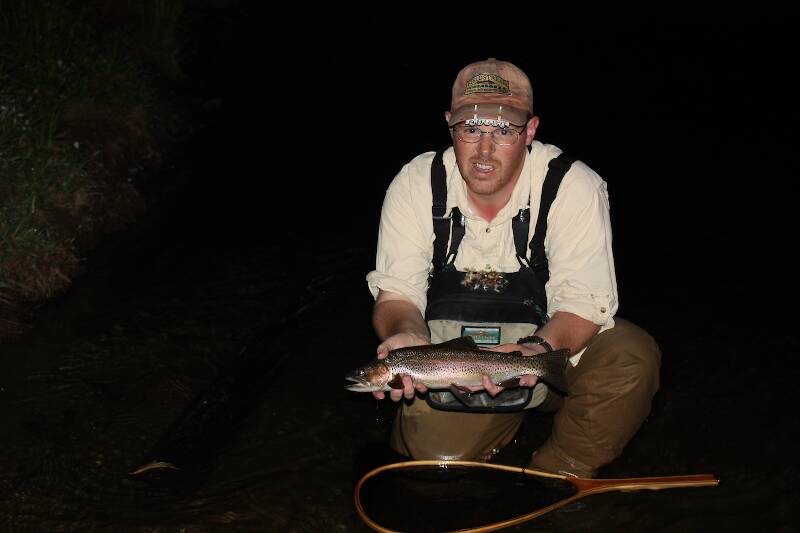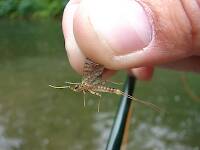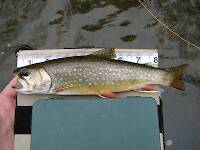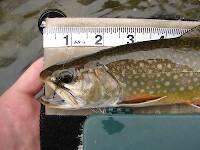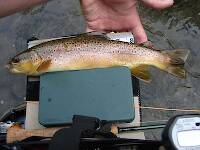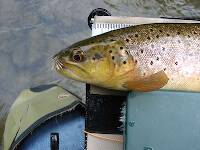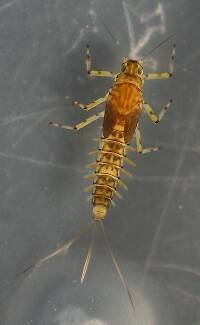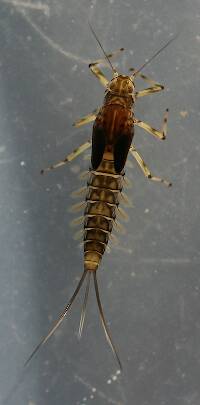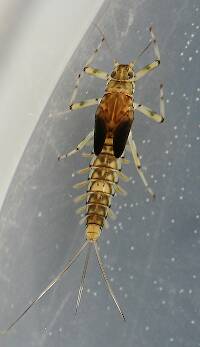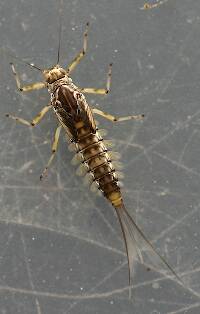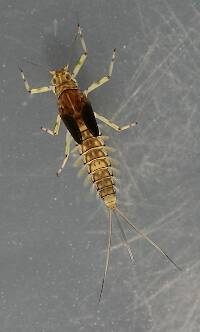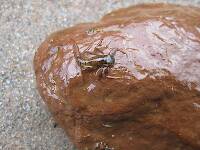
Hex Mayflies
Hexagenia limbata
The famous nocturnal Hex hatch of the Midwest (and a few other lucky locations) stirs to the surface mythically large brown trout that only touch streamers for the rest of the year.
Featured on the forum

Troutnut is a project started in 2003 by salmonid ecologist Jason "Troutnut" Neuswanger to help anglers and
fly tyers unabashedly embrace the entomological side of the sport. Learn more about Troutnut or
support the project for an enhanced experience here.
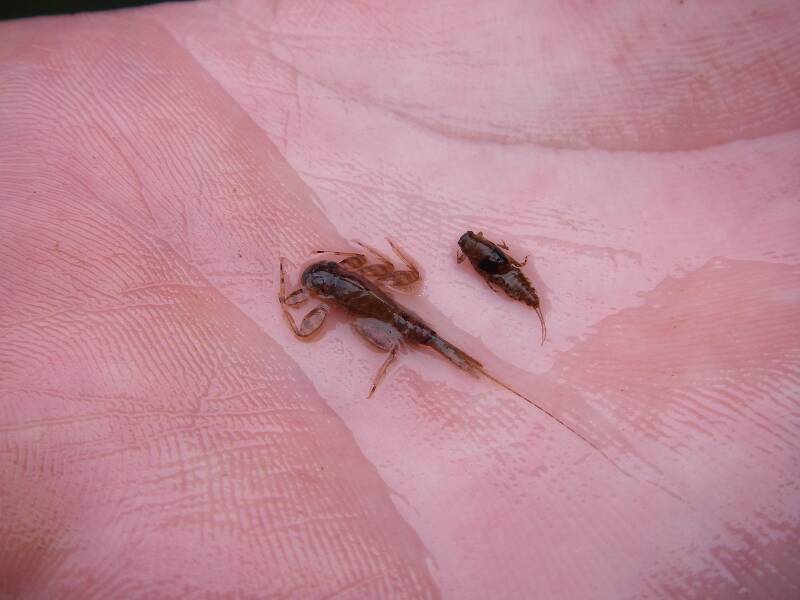
Gutcutter on Jun 11, 2010June 11th, 2010, 3:42 pm EDT
i am finally figuring out how to use my macro setting.
i seined these in mid may on a spring creek.
after the photo session, i caught a bunch of fish sight nymphing an unweighted biot body nymph that looked something like the larger specimen.
sorry about the palm of my hand, roger. i honestly do keep reminding myself to bring along a white lid. i think i left it in the right front inside pocket of spence's vest, next to the space blanket...
i seined these in mid may on a spring creek.
after the photo session, i caught a bunch of fish sight nymphing an unweighted biot body nymph that looked something like the larger specimen.
sorry about the palm of my hand, roger. i honestly do keep reminding myself to bring along a white lid. i think i left it in the right front inside pocket of spence's vest, next to the space blanket...
All men who fish may in turn be divided into two parts: those who fish for trout and those who don't. Trout fishermen are a race apart: they are a dedicated crew- indolent, improvident, and quietly mad.
-Robert Traver, Trout Madness
-Robert Traver, Trout Madness
Wiflyfisher on Jun 11, 2010June 11th, 2010, 3:53 pm EDT
Hey, you are getting there with macro shots!
The larger one looks like Maccaffertium (could be vicarium), it's definitely a clinger. The smaller nymph looks like Ephemerella (could be subvaria).... Hendrickson.
The larger one looks like Maccaffertium (could be vicarium), it's definitely a clinger. The smaller nymph looks like Ephemerella (could be subvaria).... Hendrickson.
John S.
https://WiFlyFisher.com
https://WiFlyFisher.com
Oldredbarn on Jun 11, 2010June 11th, 2010, 4:14 pm EDT
Tony,
I was wondering where that extra lid came from!!! You know I have problems already...Carry your own damn lid! Hell...Now that I think about it, one never knows when an extra lid may come in handy...I think I can squeeze it in...somewhere.
Spence
I was wondering where that extra lid came from!!! You know I have problems already...Carry your own damn lid! Hell...Now that I think about it, one never knows when an extra lid may come in handy...I think I can squeeze it in...somewhere.
Spence
"Even when my best efforts fail it's a satisfying challenge, and that, after all, is the essence of fly fishing." -Chauncy Lively
"Envy not the man who lives beside the river, but the man the river flows through." Joseph T Heywood
"Envy not the man who lives beside the river, but the man the river flows through." Joseph T Heywood
Taxon on Jun 11, 2010June 11th, 2010, 6:42 pm EDT
sorry about the palm of my hand, roger. i honestly do keep reminding myself to bring along a white lid. i think i left it in the right front inside pocket of spence's vest, next to the space blanket...
Hmmm, Tony, I would have thought better of you!
Gutcutter on Jun 12, 2010June 12th, 2010, 2:31 am EDT
sorry that there is no size reference in the photo. the Ephemerella was around a size 20. my thought was dorothea. the clinger is beyond my limited ability to even guess. what are the common cahill species in this region. plenty of dorothea and invaria hatching and dropping that evening. also a good number of "lt. cahills". could these be ithaca or canadense nymphs?
i'll be without my computer for the next few days - gotta go and chase some Megalops atlanticus, but i look forward to your thoughts.
if i start trying to identify shrimp and crabs down to the genus and species i'll need a psychiatrist (or spence) to help bring me back to sanity...
maybe (hopefully!) some photos to follow
i'll be without my computer for the next few days - gotta go and chase some Megalops atlanticus, but i look forward to your thoughts.
if i start trying to identify shrimp and crabs down to the genus and species i'll need a psychiatrist (or spence) to help bring me back to sanity...
maybe (hopefully!) some photos to follow
All men who fish may in turn be divided into two parts: those who fish for trout and those who don't. Trout fishermen are a race apart: they are a dedicated crew- indolent, improvident, and quietly mad.
-Robert Traver, Trout Madness
-Robert Traver, Trout Madness
GONZO on Jun 12, 2010June 12th, 2010, 4:48 pm EDT
the Ephemerella was around a size 20. my thought was dorothea.
Shawnny3 on Jun 13, 2010June 13th, 2010, 12:58 pm EDT
What would be other possibilities, out of curiosity? I was pleased with myself that I immediately thought March Brown and subsequently found that that's what you guys meant by Maccaffertium. But in the interest of confusing myself, I'd like to know the other options.
-Shawn
-Shawn
Jewelry-Quality Artistic Salmon Flies, by Shawn Davis
www.davisflydesigns.com
www.davisflydesigns.com
GONZO on Jun 13, 2010June 13th, 2010, 5:43 pm EDT
Shawn,
Stenacron, Maccaffertium, and Stenonema (femoratum) nymphs all look pretty similar. All are "flattened clingers" with broad rounded heads, flattened femurs, three tails, and slender (or "threadlike") 7th gills. One way to make sense of the current taxonomic scheme of this group is to remember that the other gills are pointed at the tip in Stenacron, squarish (truncated) at the tip in Maccaffertium, and rounded at the tip in Stenonema (femoratum).
Within Maccaffertium, PA species include vicarium (March Brown/Grey Fox), ithaca (sometimes called a Grey Fox, but also called a Ginger Quill), modestum, mediopunctatum, terminatum, pulchellum, and a few less common species. (Members of the last group are most often referred to as "Light Cahills," but that name is also used for Stenacron species.)
Are you confused yet?
Stenacron, Maccaffertium, and Stenonema (femoratum) nymphs all look pretty similar. All are "flattened clingers" with broad rounded heads, flattened femurs, three tails, and slender (or "threadlike") 7th gills. One way to make sense of the current taxonomic scheme of this group is to remember that the other gills are pointed at the tip in Stenacron, squarish (truncated) at the tip in Maccaffertium, and rounded at the tip in Stenonema (femoratum).
Within Maccaffertium, PA species include vicarium (March Brown/Grey Fox), ithaca (sometimes called a Grey Fox, but also called a Ginger Quill), modestum, mediopunctatum, terminatum, pulchellum, and a few less common species. (Members of the last group are most often referred to as "Light Cahills," but that name is also used for Stenacron species.)
Are you confused yet?
JOHNW on Jun 14, 2010June 14th, 2010, 11:41 am EDT
So my little taxonomic scheme of robust PT or slender PT and Big, Medium, little and tiny yellowish white bugs probably wouldn't work?
Just don't tell the trout they eat my big yellowish bugs just fine! ;)
John
Just don't tell the trout they eat my big yellowish bugs just fine! ;)
John
"old habits are hard to kill once you have gray in your beard" -Old Red Barn
Quick Reply
Related Discussions
Topic
Replies
Last Reply
4
May 24, 2008
by Softhackle
by Softhackle
6
Feb 21, 2009
by Martinlf
by Martinlf
0
Jun 29, 2020
by Wiflyfisher
by Wiflyfisher
3
Jul 22, 2014
by Entoman
by Entoman







